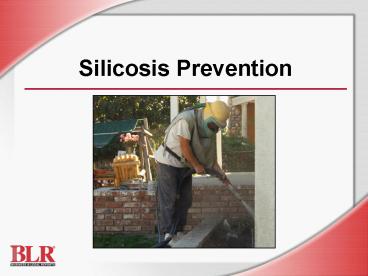Silicosis Prevention - PowerPoint PPT Presentation
1 / 29
Title:
Silicosis Prevention
Description:
Detectable by X ray after one exposure. Progresses even after removal from exposure ... Chest X ray. Evaluation for tuberculosis. Frequency of exams determined ... – PowerPoint PPT presentation
Number of Views:459
Avg rating:3.0/5.0
Title: Silicosis Prevention
1
Silicosis Prevention
2
Session Objectives
- You will be able to
- Understand what silicosis is
- Identify silica exposure risks
- Take effective precautions to prevent exposure
3
What You Need to Know
- Types of silica
- At-risk industries and jobs
- Silica exposure and forms of silicosis
- Precautions and preventive measures
- First aid for silica dust exposure
- Medical surveillance program
4
What Is Silicosis?
- Silicosis is a lung disease
- Caused by breathing dust containing silica
- Lungs become scarred and stiffened
- Breathing becomes difficult
- Risk of heart disease and tuberculosis increases
Image credit OSHA
5
Silicosis Kills
- Silicosis is disabling, incurable, and sometimes
fatal - 2 million American workers are exposed to silica
dust - 300 die each year of silicosis
6
Types of Silica
- Crystalline silica (free silica)
- Quartz, tridymite, cristobalite
- Abundant in earths crust
- Amorphous silica
- Not in the form of a crystal
- Does not cause silicosis
Image credit OSHA
7
How Dust Can Be Hazardous
- Particles are generated by work processes
- Any airborne dust can be a hazard
- Invisible particles go deep into the lungs
- Large particles are removed by mucus
- Silica-containing dust is particularly hazardous
8
Why You Might Be Unaware of the Hazards
- Crystalline silica is chemically inert
- It is naturally occurring
- It may not be properly labeled
9
At-Risk Industries and Jobs
- Mining
- Construction
- Stone cutting
10
At-Risk Industries and Jobs (cont.)
- Foundry work
- Portland cement production
- Glass manufacturing
11
At-Risk Industries and Jobs (cont.)
- Ceramics, clay, and pottery manufacturing
- Abrasive cleaning or sand blasting
- Paint, plastic, soap, and abrasives manufacturing
- Electronics production
- Filtration of food and beverages
12
Silica Exposure
- Acute exposure
- Chronic exposure
- Concentration, duration, and particle size
- Reporting symptoms
13
Chronic Silicosis
- Develops slowly over many years
- Exposure to dust with 10 percent silica
- No symptoms for 15-20 years
- Symptoms get progressively worse
- May lead to life-threatening complications
14
Accelerated Silicosis
- Results from shorter exposure at higher
concentrations - Develops within 5-15 years
- Detectable by X ray after one exposure
- Progresses even after removal from exposure
- Leads to massive fibrosis and death
15
Acute Silicosis
- Develops after 1-3 years of exposure
- Overwhelming concentrations of silica
- Symptoms appear after only 7 months
- Cough, weight loss, and fatigue
- Liquid in lungs
- Fatal within 2 years
16
Silicosis Risks
- Do you understand the information presented in
the previous slides?
17
Precautions to Prevent Exposure
- Limit the amount of dust inhaled
- Use engineering controls
- Follow safe work practices
- Make good hygiene a priority
- Use respiratory protection
Image credit Washington State Dept of Labor and
Industries
18
Silica Control Program
- Inspect work area
- Review MSDSs
- Monitor exposure levels
- Substitute other materials
19
Sampling and Monitoring
- Sampling program
- Full-shift respirable dust samples
- Personal samples
- Area samples
- Gravimetric dust collection
Image credit OSHA
20
Engineering Controls
- Use ventilation and dust collection systems
- Isolate silica dust work processes
- Suppress dust with moisture
Image credit Washington State Dept of Labor and
Industries
21
Ventilation
- General ventilation systems
- Local exhaust ventilation
- Inspection every 3 months
- Inspection when processes change
- Industrial hygiene surveys
22
Safe Work Practices
- Store silica in sealed containers
- Break caked silica loose by vibrating the outside
of a closed container - Follow confined space entry procedures
- Dont let dust accumulate
- Use a vacuum for dust removal
- Do not use compressed air for cleaning
23
Personal Hygiene
- Change into disposable or washable work clothes
- Vacuum work clothes
- Take a shower
- Put on clean street clothes
- Wash hands before eating, drinking, or smoking
- Dont bring personal items into hazardous work
areas
24
Respiratory Controls
- Wear a respirator when
- Dust exposure exceeds standard
- Engineering controls are not effective
- An emergency creates a sudden great hazard
Image credit Washington State Dept of Labor and
Industries
25
Respiratory Controls (cont.)
- Use air-purifying respirator lt 10 times PEL
- Use air-supplying respirator for higher
concentrations - Make sure respirators fit well and are worn
properly
Image credit WA State Dept of Labor and
Industries
Image credit Washington State Dept of Labor and
Industries
26
Silicosis Prevention
- Do you understand the information presented in
the previous slides?
27
First Aid
- No first aid for inhalation of silica
- Get fresh air for acute exposure
- Wash eyes
- See a doctor
28
Medical Surveillance
- Exposure above the PEL
- Physical exam including
- Medical history
- Chest X ray
- Evaluation for tuberculosis
- Frequency of exams determined by doctor
- Early diagnosis of silicosis can help control
disease
29
Key Points to Remember
- Know which work exposes you to silica
- Use engineering controls to reduce risks
- Wear respiratory protection
- Follow safe work practices
- Practice good personal hygiene
- Stop smoking































